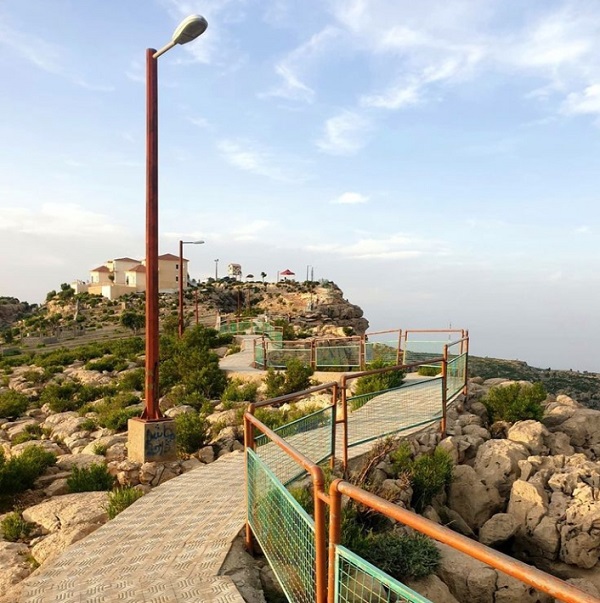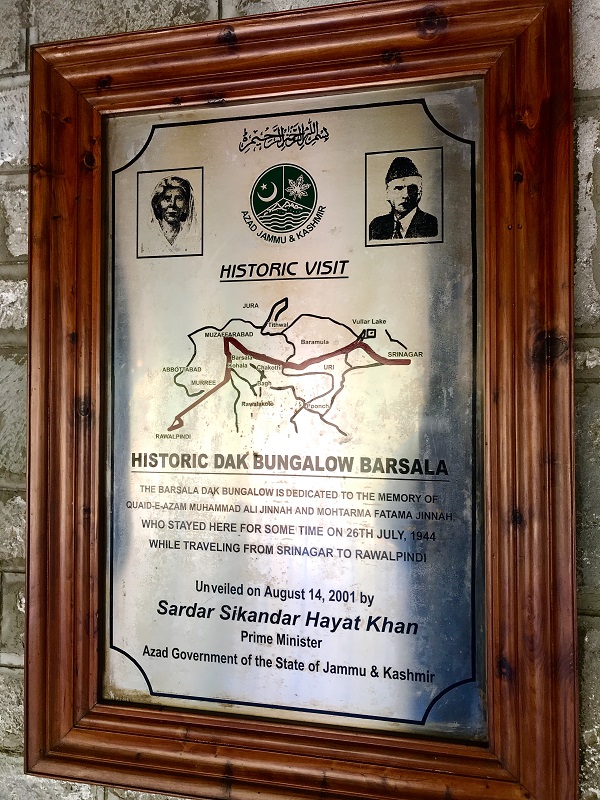Written by: Mahnaz Shujrah
Posted on: October 25, 2021 |  | 中文
| 中文
Dak Bungalow, Barsala (also known as the Quaid-e-Azam tourist lodge, Barsala). (Credit goes to Muhammad Murtaza Zaidi)
It was almost sunset when we reached our destination. The drive here from Muzaffarabad, the capital city of Azad Kashmir, was approximately thirty minutes. Our car pulled over to the side of the road. Google maps indicated that we had reached our destination, except all we could see was a Hascol petrol pump across the road to our left, and the Jhelum River rushing far below us on our right. Just then a man approached us, directing us towards a steep ramp leading downwards toward the river. Driving down carefully, after a few meters we saw a serene old-fashioned looking building, almost like a cottage. The man guiding us was the caretaker of this lodge. We had reached the famous historic Dak Bungalow at Barsala.
The first thing I noticed was the sound of rushing water, and found myself walking towards it. Standing by the railing in the garden, I had a perfect view of the sun setting over the meandering Jhelum River below. The caretaker, who had been working there since 2001, showed us to our rooms and gave us a tour of the place. Dak Bungalow Barsala is also known as the Quaid-e-Azam Tourist Lodge, commemorating the stay of Muhammad Ali Jinnah and Fatima Jinnah on 25th July 1944, on their way back to Rawalpindi from Srinagar. Dak Bungalow Barsala is in Kohala, District Muzaffarabad in Azad Jammu Kashmir (AJK).

A recent picture of the room in Dak Bungalow, Barsala where Quaid-e-Azam stayed for a night in 1944 (Credits to Dawn)
Jinnah is recorded to have visited Kashmir four times, in 1926, 1927, 1936 and 1944. During his last two visits, he was accompanied by his sister Fatima Jinnah. The duration of his visit to Kashmir in 1944 was from 10th May till 25th July. There were other dak bungalows along this route where he stayed, such as in Jammu and Khanabal.
Dak bungalow (post bungalow), dakbangla and dak house (post house) are all names for the official buildings used to host officers during the British Raj in India. The term “dak bungalow” emerged in mid-19th century, when the British started constructing rest houses in the subcontinent, primarily for sending mail (dak in Urdu). These lodges, along with other Circuit Houses, were widely used by British officials in India, and were located after intervals of ten to twenty miles.
It appears that the British invented a network of rest areas, although this concept existed prior to their arrival in the Indian subcontinent. In pre-modern times, the primary mode of traveling used to be by foot or on horses, hence lodges and inns were established after reasonable intervals on major trade routes, for example the Grand Trunk Road. Rulers used to commission the construction of caravanserais, a large, open complex, consisting of many rooms and a well for water. Many of these structures from the Mughal period have survived but are no longer functional, such as the Akbari Serai in Shahdara, Lahore. Similarly, dharamshalas, rest houses for pilgrims, were also built throughout India. While caravanserais were for large traveling groups or caravans, dharamshalas were mostly for travelers undertaking a religious journey or pilgrimage, and were found closer to sacred sites.
There is a deep and intricate history behind dak bungalows, but broadly speaking they can be placed into three categories. First is the original dak bungalow, constructed by the British, usually under the Public Works Department (PWD). These were meant to serve as government guest houses, and they could vary in size and style depending on the region. Many of these were circuit houses, which also served as residences for officials posted in different areas. The second type of dak bungalows were established in already existing historic buildings. Basically, PWD would take over a building and refurbish it to serve a new purpose. This practice was common in the princely states, as they had an abundance of palaces, forts and purpose-built structures. Some of these were then converted into dak and inspection bungalows during the British rule, while a few retained their original structures, others were completely altered. The third type of dak bungalows were lodges to begin with, but were transformed into museums or libraries in present day South Asia. Interestingly, there is even a line of cuisine inspired by dak bungalows, such as the Dak Bungalow Curry, which is quite popular in modern day subcontinent, showcasing the link between institutions and culture.
The history of the dak bungalow in Barsala is unique, in the sense that it was not built by the British or the Mughals. The dak bungalow was originally built by the Dogra Dynasty who ruled Kashmir from early 19th century till the time of Partition. Gulab Singh, an important noble in the court of Ranjit Singh, was the founder of the dynasty. Ranjit Singh is credited with having mapped out many of the main roads which exist in Kashmir even today. The dak bungalows were built at intervals of ten to fifteen miles in order to facilitate the rulers traveling on horses. The British later took over these existing complexes and converted some of them for their own use, of which the dak bungalow at Barsala is an example. It lies on the main route used by Ranjit Singh and the Dogras. The present building is an amalgamation of different influences mixed with the local architectural Pahari design.

The plaque hung on the walls of the Dak Bungalow, Barsala, listing the details of Quaid-e-Azam's stay here
There is a wall plaque hanging in the main veranda, which was unveiled by the AJK Prime Minister, Sardar Sikander Hayat Khan, on the 14th of August 2001. Due to its rundown condition, the building was shut down for a long time after Partition. However, it was opened to visitors after it was restored and refurbished in 2001. The earthquake in 2005 also caused damage to many buildings, but fortunately this structure survived, and the damage to it was addressed. Today, the Dak Bungalow at Barsala is a popular attraction site for tourists and history enthusiasts. The short walk down to the river is a perfect opportunity to appreciate the raw and natural beauty of Kashmir.
You may also like: